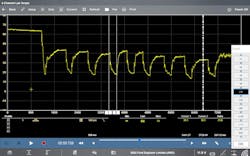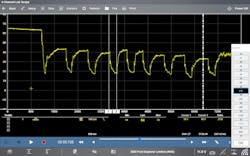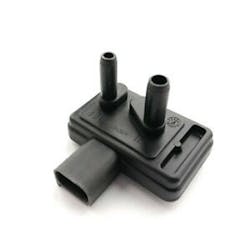Diagnostic investigation using a pressure transducer
Pressure transducers can be valuable in the diagnostic fault-finding process in many different ways. The pressure transducer can be used to look at fluid pressures such as fuel, transmissions, and hydraulics as well as gas pressures, such as compression, manifold, and exhaust backpressure.
So why would a technician use a pressure transducer to look at fluid pressure?
The pressure transducer allows them to see waveforms created by pressure changes within the system that they are connected to. This can help to diagnose whether the component is functioning correctly by monitoring the change in pressure when a component actuates.
When looking at gas pressures, the technician will be looking for a change in the pressure waveforms from test areas such as fuel, transmission, hydraulics, cylinder, manifold, exhaust, etc. If the spark plug is removed and a pressure transducer is connected, the cylinder can then generate waveforms of the pressure changes in the cylinder during the four-stroke cycle. They can then compare the waveforms for each cylinder to identify any issues.
How to Setup
Snap-on's pressure transducer adaptor (EEMS324PSA) is compatible with Snap-on's handheld diagnostic tools that include a scope; MODIS, TRITON, VERUS and ZEUS. There are three different types of Snap-on pressure transducers that come in either 0 – 100 psi, 0 – 500 psi, or 0 – 5,000 psi, which transducer to use depends on what they want to measure. Connect the transducer to the scope by using either a split lead adapter for a four-channel scope or a PSA adapter that will work with two or four channel scopes and is battery powered.
Case Study
This case was with a 2002 Ford Explorer, a no-start after a PCM install. The PCM was replaced at another shop, so the full history was not available.
The engine did start after a parameter reset, but a short time later it wouldn't start again. So, some initial checks were carried out:
- The vehicle was checked for spark and that was okay
- The PCM was checked to ensure the right one was fitted and working correctly and that was okay
- A fuel check was conducted using a manual analogue gauge
When checking the fuel, it was noticed that when the engine was cranked, the needle on the manual gauge was fluctuating wildly, almost following the pulse of the engine. A little fluctuation would be expected, but not to that extent, so that prompted a closer look using Snap-on ZEUS and a pressure transducer.
The pressure transducer was connected into the fuel line. As the key was turned in the ignition, it could be seen that the fuel pressure builds slowly (as it should), up to a little over 60 psi, which is normal pressure for this particular vehicle.
When cranking begins, a pattern starts to occur. The pattern goes from a little over 60 psi down to 20 psi and then up to a little over 40 psi and then down to 20 psi, and 40 and 20 and back and forth. This corresponds to where the fluctuation was seen on the manual fuel gauge, equating to a huge drop in pressure when the vehicle is turned over (cranked).
If fuel pressure is being lost, perhaps that's why it's not starting.
It’s time to investigate a little further by hooking up to an injector and checking both the injector and the fuel pressure at the same time. In this example, the pressure is on the yellow channel (channel one), the green channel is the fuel injector (power voltage) and the blue channel is the AMP probe, to make sure that fuel injector is opening.
By looking at these parameters together, we can see that when the fuel injector opens, it is exactly when the fuel pressure drops. It is a big drop, from 60 psi to 30 psi in this case. The huge drop every time it cranks means the vehicle is not able to build up enough pressure. It’s basically bleeding off too much when it fires. Now, why is it bleeding off so much pressure?
If we look at the ‘on time’ for that injector, it's 250 milliseconds (0.25 secs). That is a large amount of ‘on time’ during normal temperatures. It is significantly more than it should be, so needs to be investigated.
There were also many codes in the vehicle. On review of the codes, it was found that the DPFE sensor was shorted on the VREF circuit. The DPFE is the EGR differential pressure sensor and it had shorted when it was plugged in. The 5V reference circuit had dropped to about 0.5V, (4/10ths of a volt). If it was unplugged, it went back up to 5V. That determined that the sensor was shorted internally, pulling that voltage down to ground.
The sensor was replaced and the same test was repeated to verify that the same pattern was no longer happening. The same process was followed to hook up the channels and we can see that the pressure stays around 60 psi and then it drops down to 50 psi and then builds its way back up. We can see where the injector closes and the pressure builds until we see the next injector firing event happens. The ‘on time’ is back down to approximately 36 milliseconds – a much more reasonable ‘on time.’
The readings are now back in line with what is expected when operating correctly.
So, what happened? The hypothesis is if it shorted down to 0.5V, via the 5V reference system (VREF), the other sensors that are connected to that five-volt reference system are then affected. When the voltage on that one sensor is pulled down, then all of the connected sensors are going to read incorrectly. In this case, it appears that the cooling temp sensor failed on the low side and that is what lead to the injector ‘on time’ being affected.
This is just one way of hooking up a scope and using a pressure transducer to help visualize the pattern and aid the diagnosis.
More information and examples can be found within the guided component test area of the Snap-on MODIS, TRITON, VERUS, and ZEUS. There is a 15-minute pressure transducer diagnostic class and a 10-minute running compressions waveform class.
As well as finding helpful classes on the Snap-on handheld tools, technicians can also benefit from the extensive library of educational YouTube videos. This particular case study was just one of the examples that was covered in Snap-on Live Training Episode 32.
Information provided by Snap-on Diagnostics
About the Author

Damien Coleman
Damien Coleman started as an apprentice in 1999 at a GM dealership. In 2003 he competed in the final of the national skills competition. He completed his diploma in advanced automobile engineering and automobile electricity in 2004. In 2006 Coleman joined and started his career at Snap-on. In his spare time he has lectured at the Cork Institute of Technology, teaching automotive diagnostics.





